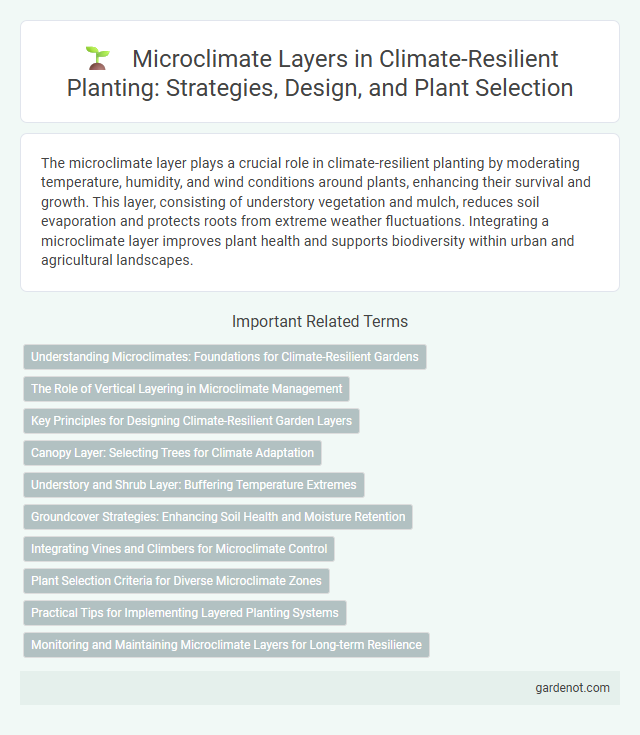The microclimate layer plays a crucial role in climate-resilient planting by moderating temperature, humidity, and wind conditions around plants, enhancing their survival and growth. This layer, consisting of understory vegetation and mulch, reduces soil evaporation and protects roots from extreme weather fluctuations. Integrating a microclimate layer improves plant health and supports biodiversity within urban and agricultural landscapes.
Understanding Microclimates: Foundations for Climate-Resilient Gardens
Microclimate layers play a crucial role in creating climate-resilient gardens by influencing temperature, humidity, wind patterns, and sunlight exposure at a localized scale. Understanding factors such as soil moisture retention, shade from vegetation, and heat absorption by surfaces enables the design of microclimates that protect plants from extreme weather conditions. Integrating microclimate knowledge supports the selection of suitable plant species, improves water efficiency, and enhances garden resilience against climate variability.
The Role of Vertical Layering in Microclimate Management
Vertical layering in climate-resilient planting significantly enhances microclimate management by creating diverse strata that regulate temperature, humidity, and wind exposure. This stratification mimics natural ecosystems, improving air circulation and shading, which reduces soil evaporation and thermal stress on plants. Optimizing vertical layers supports biodiversity, promotes soil health, and increases overall climate adaptability in agricultural and urban landscapes.
Key Principles for Designing Climate-Resilient Garden Layers
Microclimate layer design in climate-resilient gardens involves selecting plants that moderate temperature extremes, improve soil moisture retention, and provide wind protection. Key principles include layering vegetation to create shade, enhance humidity, and reduce evaporation, thereby supporting diverse plant health and boosting ecosystem stability. Proper arrangement of these layers optimizes microclimatic benefits, fostering resilient growth amid changing climate conditions.
Canopy Layer: Selecting Trees for Climate Adaptation
Choosing tree species for the canopy layer enhances microclimate regulation by providing shade, reducing temperature extremes, and improving humidity control. Climate-resilient trees such as oaks, maples, and pines offer drought tolerance and pest resistance, supporting ecosystem stability under changing conditions. Strategic canopy planting strengthens urban heat island mitigation and fosters biodiversity, critical for long-term climate adaptation.
Understory and Shrub Layer: Buffering Temperature Extremes
The understory and shrub layer play a crucial role in buffering temperature extremes by creating a protective microclimate that reduces heat and cold stress for the ecosystem. These layers provide shade, retain moisture, and moderate ground temperatures, enhancing plant resilience and biodiversity. Effective management of microclimate layers supports climate-resilient planting strategies by stabilizing local temperature fluctuations.
Groundcover Strategies: Enhancing Soil Health and Moisture Retention
Groundcover strategies play a crucial role in climate-resilient planting by improving soil health and increasing moisture retention. Using organic mulches, cover crops, and low-growing vegetation layers reduces soil erosion, moderates soil temperature, and enhances water infiltration. These practices support microbial activity, boost soil organic matter, and create a stable microclimate that helps plants withstand drought and temperature extremes.
Integrating Vines and Climbers for Microclimate Control
Integrating vines and climbers in climate-resilient planting creates a microclimate layer that moderates temperature extremes and enhances humidity control around crops. These plants improve air circulation and provide shading, reducing heat stress and water evaporation in agricultural systems. Strategic placement of vines and climbers supports sustainable microclimate regulation, boosting overall ecosystem resilience.
Plant Selection Criteria for Diverse Microclimate Zones
Plant selection criteria for diverse microclimate zones prioritize species with adaptive traits such as drought tolerance, shade resilience, and temperature flexibility to enhance survival and growth. Understanding soil moisture variability, light exposure, and wind patterns within microclimates informs choosing plants that optimize water use efficiency and reduce irrigation needs. Selecting native or well-adapted species aligned with microclimate conditions supports ecosystem stability and improves long-term climate resilience.
Practical Tips for Implementing Layered Planting Systems
Incorporate diverse plant species with varying heights and root depths to create a microclimate layer that moderates temperature and retains soil moisture. Use ground covers to reduce evaporation, shrubs to provide shade and wind protection, and taller trees to buffer extreme weather conditions. Regularly monitor soil moisture and plant health to adjust layering for optimal resilience against climate stressors.
Monitoring and Maintaining Microclimate Layers for Long-term Resilience
Monitoring microclimate layers involves using advanced sensors to track temperature, humidity, and soil moisture, ensuring optimal conditions for plant growth. Maintaining these layers requires regular assessment and adaptive management techniques like mulching and strategic planting to enhance thermal regulation and water retention. Long-term resilience depends on continuous microclimate data analysis to inform adjustments that mitigate environmental stressors and promote sustainable ecosystem health.
Microclimate layer Infographic

 gardenot.com
gardenot.com